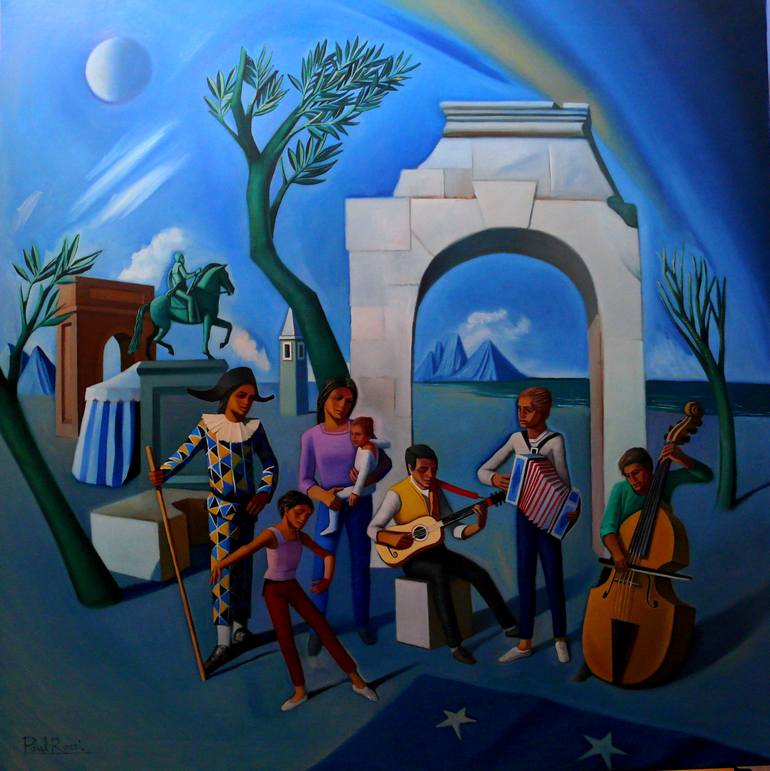







VIEW IN MY ROOM
Harlequin IV Painting
United Kingdom
Painting, Oil on Canvas
Size: 40 W x 40 H x 2 D in
Ships in a Box
Shipping included
14-day satisfaction guarantee
Artist Recognition

Artist featured in a collection
About The Artwork
This work is a parodic treatment of Christian Nativity paintings, most especially of the kind to be seen in 15th century Italian art. The work is one of a recent series of paintings and drawings which attempt to speculate on the cosmological themes and motifs that we typically find in the infancy narratives of the New testament writings, but in the forms and disguises that are familiar to us from early modernist art. They are therefore an an attempt to defamiliarize an apparently very familiar myth which precisely because of its familiarity could take on the relative invisibility of those things whose meanings have been half-forgotten, or obscured by habitual and hackneyed usage (This approach has been suggested by the Russian Formalist school of literary criticism). These works aim to effect a 'strange-making' through a recontextualization, the purpose of which is renewed perception and disclosure. Just as the early modernist painters in their preoccupation with the worlds of the circus, Commedia del Arte, the saltimbanque, presented what amounted to a metaphor for the human predicament of their time, so I am trying to present a vision of humanity as I conceive its actual and perennial predicament: a people living on the edge, amidst the symbols , the objects, and landscape that are emblematic of their, and our, existential status. They exist within a symbolic landscape referencing the ancient imperial world, a political, hierarchical order which may be historically defunct but which yet casts its shadow over them, counterpointing their exposure and vulnerability. The classical references are not, therefore, intended to suggest neoclassical meanings; on the contrary. The signs of imperial order and power form the stage setting for an itinerant hiumanity, which although marginal and exposed, nevertheless fully participates in the world's game by dancing to the music of time and creation. They represent the counter to the imperial culture that is still very much at the centre of contemporary reality, an opposition, a defiance, which they embody through the simple act of being in communion with each other, being at play, and thus being creative in the act of making music and of dance. I imagine them to embody a reality that we find expressed in the Indian poet Vassava: "Things standing shall fall, but the moving shall ever stay." In play, in music, they make real their freedom, their detachment from the chain of coercion that is always forged by imperial power, whether that power is political, religious, or corporate in nature. Following Schiller, Jean-Paul Sartre said this: "If man Knows himself to be free and desires to use hid freedom then this activity is play." For in the freedom of play we release an imagination trapped in fear, in routine and habit, and only in so doing can we break the bonds of the status quo. The significance of the game is essentially that of art: the construction of counter-worlds which might hold out the possibility of a future that is not a reiteration of the past. Liberation takes place through the playing of games, that is to say, through the making of art.
Details & Dimensions
Painting:Oil on Canvas
Original:One-of-a-kind Artwork
Size:40 W x 40 H x 2 D in
Frame:Not Framed
Ready to Hang:Not applicable
Packaging:Ships in a Box
Shipping & Returns
Delivery Time:Typically 5-7 business days for domestic shipments, 10-14 business days for international shipments.
Handling:Ships in a box. Artists are responsible for packaging and adhering to Saatchi Art’s packaging guidelines.
Ships From:United Kingdom.
Customs:Shipments from United Kingdom may experience delays due to country's regulations for exporting valuable artworks.
Have additional questions?
Please visit our help section or contact us.
United Kingdom
Artist Recognition

Artist featured by Saatchi Art in a collection
Thousands Of Five-Star Reviews
We deliver world-class customer service to all of our art buyers.
Global Selection
Explore an unparalleled artwork selection by artists from around the world.
Satisfaction Guaranteed
Our 14-day satisfaction guarantee allows you to buy with confidence.
Support An Artist With Every Purchase
We pay our artists more on every sale than other galleries.
Need More Help?